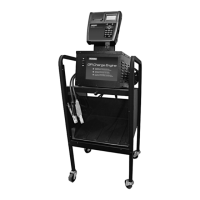5:/057
0LWL,06WWL,
LWL
,PSRUWDW6DIHW,VWUFWlRV
5LVNRIHSORVLYHDVHV
DWWHULHVJHQHUDWHHSORVLYHJDVHVGXULQJ
QRUPDORSHUDWLRQDQGZKHQGLVFKDUJHGRU
FKDUJHG
1.1 WORKING IN THE VICINITY OF A LEAD-ACID BATTERY
IS DANGEROUS. BATTERIES GENERATE EXPLOSIVE
GASES DURING NORMAL BATTERY OPERATION, AND
WHEN DISCHARGED OR CHARGED. FOR THIS REASON,
IT IS OF UTMOST IMPORTANCE THAT BEFORE USING
YOUR CHARGER, YOU READ THIS MANUAL AND FOL-
LOW THE SAFETY AND OPERATING INSTRUCTIONS EX-
ACTLY.
1.2 To reduce risk of battery explosion, follow these safety in-
structions and those published by the battery manufac-
turer and the manufacturer of any equipment you intend
to use in the vicinity of a battery. Review cautionary mark-
ing on these products and on the engine, and on the ve-
hicle or equipment containing the battery.
KDULDRUHFKDUHDEOHEDWWHU
PDFDXVHWKHEDWWHUWREXUVW
7RUHGXFHWKHULVNRILQMXURQOFKDUJH
rechargeable ooded-type batteries including
PDLQWHQDQFHIUHHORZPDLQWHQDQFHRUGHHS
FFOHEDWWHULHV
If you are uncertain as to the type of battery you are at-
tempting to charge, or the correct procedure for checking
the battery’s state of charge, contact the seller or battery
manufacturer.
1.3 Use of an attachment not recommended or sold by the
battery charger manufacturer may result in a risk of re,
electric shock, or injury to persons.
1.4 To reduce risk of damage to the electric plug and cord,
pull by the plug rather than by the cord when disconnect-
ing the charger.
1.5 Position the AC and DC leads to avoid tripping over them
and to prevent damage by hood, doors, or moving engine
parts; protect from heat, oil, and sharp edges.
1.6 Do not operate the charger if it has received a sharp blow,
been dropped or otherwise damaged in any way; take it
to a qualied service center.
1.7 Do not disassemble charger; take it to a qualied service
center when repair is required. Incorrect reassembly may
result in a risk of electric shock or re.
1.8 To reduce risk of electric shock, unplug the charger from
the AC outlet before attempting any maintenance or
cleaning. Turning o the controls will not reduce this risk.
5HPRYHPDULHERDWEDWWHULHVDG
FKDUHWKHPRVKRUH
KDUJLQJPDULQHEDWWHULHVRQERDUGUHTXLUHV
VSHFLDOOGHVLJQHGHTXLSPHQWIRUPDULQHXVH
1.9 Connect and disconnect the battery leads only when the
AC supply cord is disconnected.
1.10
Do not overcharge the battery. (See sections 3 and 10 in
the safety instructions)
1.11
Charge the battery in a dry, well-ventilated area.
1.12
Never place articles on or around the charger, or locate
the charger in a way that will restrict the ow of cooling
air through the cabinet.
1.13
An extension cord should not be used unless absolutely
necessary. (See paragraph 4.3.)
1.14
Have a damaged cord or plug replaced immediately.
1.15
Do not expose the charger to rain or snow.
3HUVRDO3UHFDWlRV
2.1 Always have someone within range of your voice, or close
enough to come to your aid, when working around lead
acid batteries.
2.2 Have plenty of fresh water and soap nearby in case battery
acid contacts skin, clothing or eyes.
2.3 Wear complete eye protection, clothing protection, and
wear rubber soled shoes. Place damp cloth over battery
to protect against acid spray. When ground is very wet or
covered with snow, wear rubber boots. Avoid touching
eyes while working near battery.
2.4 If battery acid contacts skin or clothing, wash immediately
with soap and water. If acid enters the eye, immediately
ush with cold running water for at least 10 minutes, and
seek medical attention.
2.5 NEVER smoke or allow a spark or ame in vicinity of a bat-
tery or engine.
2.6 Be extra cautious to reduce risk of dropping a metal tool
onto the battery. It might spark or short circuit the battery
or other electrical part that may cause an explosion.
6DIHW,VWUXFWLRV
6DIHW,VWUXFWLRV

